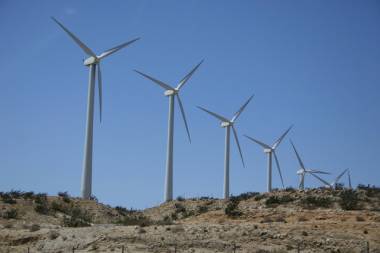|
Wind Turbines
Wind turbines are modern windmills used to generate electricity. They can be either horizontal or vertical shaft, but most are horizontal shaft design. The main reason for this is the greater efficiency of horizontal shaft turbines. There are three main components of a turbine system: the blades, the generator and the tower to support them. The blades of course capture the energy of the wind that rotates the shaft. As I explained on the Wind Power page, wind turbine blades use the aerodynamic principle of lift to operate at maximal efficiency. The rotational speed of the shaft driven directly by the blades is usually too slow to drive a generator, so a series of gears increases the speed of the generator’s drive shaft to the proper level. Useful power is thereby generated. The principles are fairly straight-forward, but success depends on attention to a lot of details. Accurate knowledge of the characteristics of available wind on a specific site is critical for success. Large commercial projects use available historical information for a region to screen for possible sites, but that’s only a screen. Before planners commit to a project, they measure and record the wind frequency and speed on the site itself for an entire year. Large projects are simply too expensive to skimp on this evaluation. As I talk about on the Home Wind Power page, even smaller projects need evaluation and planning, but probably not a full year of measuring. Wind turbines generally operate when the wind speed is between 6 and 55 miles per hour. I won’t go into the math here (OK – I had a little trouble explaining it when I tried), but when the wind speed doubles, the output of a wind turbine increase eight times. Although higher wind speeds are good, there is such a thing as too much of a good thing. Higher wind speed greatly increased the mechanical wear and tear on the structure. Depending on the design, it might also risk burning out the electrical components. Most wind turbines are designed to adjust for this in one manner or another. Smaller ones will generally turn out of the wind so they don’t turn as quickly. Larger ones usually have blades with adjustable pitch. If the wind speed becomes excessive, the pitch shifts to make the blade less efficient and therefore turn more slowly. Another factor influencing power output is the diameter of the rotors. Naturally, the large the rotor the more power, but it’s not a straight line relationship. Double the rotor diameter and the power output increases by a factor of four. The biggest wind turbine rotor I’m aware of is 413 feet in diameter. It’s on a wind turbine in Emden, Germany. Diameters in the 60’-200’ range are more common. The tower is important because wind turbines need to be fairly high up to be efficient. Winds speeds tend to be higher and the air flow less turbulent well above the ground and any obstructions to wind flow such as trees or buildings. Although solitary turbines are sometimes erected, usually a group of towers are put up on a suitable site. This collection is called a wind farm. As I talk about on another page, various groups have raised objections to wind farms, but as time goes by better design and planning are eliminating most concerns. Commercial wind turbines and wind farms will be part of our long-term energy solution. On a smaller scale, many homeowners are using small wind turbines to produce their own power. Sometimes they even produce enough electricity to sell some to the energy companies. I describe these smaller wind turbine projects on the Home Wind Power page. LinksClick here to return to Alternative Energy Primer Home from Wind Turbines |
